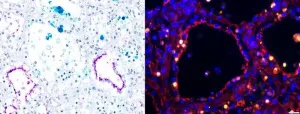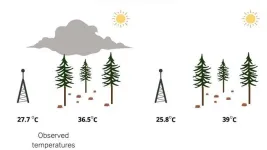(Press-News.org) Waltham — July 15, 2024 — The strengths of academic psychiatry departments and the fast-growing private telehealth sector are complementary, according to a Perspective article published in Harvard Review of Psychiatry, part of the Lippincott portfolio from Wolters Kluwer. Justin A. Chen, MD, MPH, a psychiatrist at Weill Cornell Medicine in New York City, and colleagues reviewed literature on provision of outpatient mental health care in the United States. They concluded that academic psychiatry departments and telehealth companies could mutually benefit from strategic collaboration.
Academic medical centers struggle to meet demand for outpatient psychiatric care
An overwhelming number of mental health referrals, coupled with chronic under-reimbursement and increasing “bad debt,” has driven some hospitals to shrink or eliminate their outpatient psychiatric services the reviewers note. Many institutions also struggle to discharge outpatients who prefer or have become accustomed to long-term care.
Meanwhile, the growing private telehealth sector is developing novel technology to improve access to care, demonstrate data-driven outcomes, and advocate for improved payer reimbursement.
The option to refer patients to telehealth companies would allow academic institutions to refocus on their missions—providing specialized and higher levels of care, education/training, and research—Dr. Chen's group emphasizes. Companies that demonstrate quality care for a wide range of diagnoses and illness severities could assume a critical role as primary mental health providers for a large segment of the U.S. population, facilitating development of long-term care relationships that many patients and clinicians value.
"As some patients will inevitably resist discharge to a telehealth service and/or a new provider, academic ambulatory programs will need to develop structural methods for clearly communicating this model to patients from the outset of treatment," the authors say. "Furthermore, long waitlists—frustrating to patients and referring clinicians alike—could be shortened by identifying patients who are unlikely to require academic resources and triaging these individuals directly to telehealth companies."
Hallmarks of a well-functioning, properly integrated referral system
Academic centers are positioned to discern between higher and lower quality telehealth companies, the authors point out. To ensure partnerships with telehealth companies benefit all parties, they advise academic centers to:
Develop a formulary of diverse partner companies that can provide quality care for patients with a range of characteristics, including severe mental illness; underrepresented racial/ethnic, sexual, and gender minority backgrounds; limited English proficiency; children and adolescents; and public payer insurances.
Provide partner companies with prescreened patients and relevant medical documentation, and ensure preferential access to academic centers’ higher levels of care in cases of clinical decompensation or psychiatric complexity.
Create standardized pathways for referring out stabilized patients.
Develop meaningful clinical outcome measures that better capture the effects of mental health interventions, factoring in illness severity and chronicity.
Offer paid continuing education and/or supervision to clinicians at telehealth companies.
Communicate transparently with patients about industry relationships, noting the benefits of having a trusted institution evaluate companies and refer directly to the appropriate resource.
"The administrative bureaucracy of academic centers may slow negotiations and the formation of partnerships," Dr. Chen and his colleagues acknowledge. "Although this may delay progress, it could also present an important layer of oversight for a sector currently lacking adequate external regulation. Likewise, the technology sector's nimbleness and speed may provide a necessary nudge to an academic world that is often slow to adapt."
Read Article: Finding Our Lanes: A Roadmap for Collaboration Between Academic Medical Centers and Behavioral Telehealth Companies
Wolters Kluwer provides trusted clinical technology and evidence-based solutions that engage clinicians, patients, researchers and students in effective decision-making and outcomes across health care. We support clinical effectiveness, learning and research, clinical surveillance and compliance, as well as data solutions. For more information about our solutions, visit https://www.wolterskluwer.com/en/health.
###
About Wolters Kluwer
Wolters Kluwer (EURONEXT: WKL) is a global leader in information, software, and services for professionals in health care, tax and accounting, financial and corporate compliance, legal and regulatory, and corporate performance and ESG. We help our customers make critical decisions every day by providing expert solutions that combine deep domain knowledge with specialized technology and services.
Wolters Kluwer reported 2023 annual revenues of €5.6 billion. The group serves customers in over 180 countries, maintains operations in over 40 countries, and employs approximately 21,400 people worldwide. The company is headquartered in Alphen aan den Rijn, the Netherlands.
For more information, visit www.wolterskluwer.com and follow us on LinkedIn, Facebook, and YouTube.
END
Academic psychiatry urged to collaborate with behavioral telehealth companies
The complementary strengths of the two types of organizations could create “elegant synergy” and result in more coordinated, equitable mental health systems
2024-07-15
ELSE PRESS RELEASES FROM THIS DATE:
NASA’s Webb investigates eternal sunrises, sunsets on distant world
2024-07-15
Researchers using NASA’s James Webb Space Telescope have finally confirmed what models have previously predicted: An exoplanet has differences between its eternal morning and eternal evening atmosphere. WASP-39 b, a giant planet with a diameter 1.3 times greater than Jupiter, but similar mass to Saturn that orbits a star about 700 light-years away from Earth, is tidally locked to its parent star. This means it has a constant dayside and a constant nightside—one side of the planet is always exposed to its star, while the other is always shrouded in darkness.
Using Webb’s NIRSpec (Near-Infrared ...
Receptors make dairy cows a prime target for influenza, ISU team finds
2024-07-15
AMES, Iowa – As highly pathogenic avian influenza has spread in dairy herds across the U.S., the virus is being detected in raw milk. A new study by a broad team of researchers at Iowa State University’s College of Veterinary Medicine helps explain why.
Sialic acid, a sugar molecule found on the surface of some animal cells, acts as a receptor for influenza. Without sialic acid providing an entry point to attach, invade and infect, a flu virus is unlikely to find a potential host hospitable.
Before the recent HPAI outbreak ...
A new neural network makes decisions like a human would
2024-07-15
Humans make nearly 35,000 decisions every day, from whether it’s safe to cross the road to what to have for lunch. Every decision involves weighing the options, remembering similar past scenarios, and feeling reasonably confident about the right choice. What may seem like a snap decision actually comes from gathering evidence from the surrounding environment. And often the same person makes different decisions in the same scenarios at different times.
Neural networks do the opposite, making the same decisions each time. Now, Georgia Tech researchers in Associate Professor Dobromir Rahnev’s lab are ...
Wojtusiak to use artificial intelligence to help caregivers with social isolation
2024-07-15
Janusz Wojtusiak, Professor, Health Administration and Policy, College of Public Health, is set to receive funding for the project: “An Artificial Intelligence Solution to Social Isolation and Longlines of Caregivers of People with Dementia.”
Wojtusiak and his graduate student Ghaida Alsadah will lay the foundation for a large study aimed at utilizing AI methods to address social isolation and loneliness among people who care for those with Alzheimer’s Disease and those suffering from dementia.
Addressing ...
You're just a stick figure to this camera
2024-07-15
Images
A new camera could prevent companies from collecting embarrassing and identifiable photos and videos from devices like smart home cameras and robotic vacuums. It's called PrivacyLens and was made by University of Michigan engineers.
PrivacyLens uses both a standard video camera and a heat-sensing camera to spot people in images from their body temperature. The person's likeness is then completely replaced by a generic stick figure, whose movements mirror those of the person it stands in for. The accurately animated stick figure allows a device relying on the ...
Scorching storms on distant worlds revealed in new detail
2024-07-15
Astronomers have created the most detailed weather report so far for two distant worlds beyond our own solar system.
The international study – the first of its kind – reveals the extreme atmospheric conditions on the celestial objects, which are swathed in swirling clouds of hot sand amid temperatures of 950C.
Using NASA’s powerful James Webb Space Telescope (JWST), researchers set out to capture the weather on a pair of brown dwarfs – cosmic bodies that are bigger than planets but smaller than stars.
These brown dwarfs, named collectively ...
JWST unveils stunning ejecta and CO structures in Cassiopeia A's young supernova
2024-07-15
July 15, 2024, Mountain View, CA -- The SETI Institute announced the latest findings from the James Webb Space Telescope (JWST) of the supernova remnant, Cassiopeia A (Cas A). These observations of the youngest known core collapse supernova in the Milky Way provide insights into the conditions that lead to the formation and destruction of molecules and dust within supernova ejecta. The study’s findings change our understanding of dust formation in the early universe in the galaxies detected by JWST 300 million years after the Big Bang. ...
UC Irvine Earth system scientists discover missing piece in climate models
2024-07-15
Irvine, Calif., July 15, 2024 — As the planet continues to warm due to human-driven climate change, accurate computer climate models will be key in helping illuminate exactly how the climate will continue to be altered in the years ahead.
In a study published in the Journal of Geophysical Research: Atmospheres, a team led by researchers from the UC Irvine Department of Earth System Science and the University of Michigan Department of Climate and Space Sciences and Engineering reveal how a climate model commonly used by geoscientists currently overestimates ...
Wildfire smoke has a silver lining: It can help protect vulnerable tree seedlings
2024-07-15
CORVALLIS, Ore. – Forest scientists at Oregon State University studying tree regeneration have found that wildfire smoke comes with an unexpected benefit: It has a cooling capacity that can make life easier for vulnerable seedlings.
An OSU College of Forestry collaboration led by faculty research assistant Amanda Brackett made the discovery while working to determine the effect of forest canopy cover on summer maximum temperatures near ground level.
The study’s goal was to describe how heat waves and other future climate conditions might affect canopy cover’s influence on temperature. The scientists used previously established heat stress responses of seedlings from ...
How does superglue work, and what the heck is electroadhesion? (video)
2024-07-15
WASHINGTON, July 15, 2024 — How would you stick a slice of banana to a sheet of copper? Until a few months ago, you couldn’t. But a new discovery called “hard-soft electroadhesion” enables chemists to stick almost any hydrogel to almost any metal, using nothing but an electric current. And you can unstick the materials simply by reversing the current. Recently reported in ACS Central Science, this astonishingly general phenomenon works with a wide variety of gels (including fruits, vegetables, meat and fish) and conductors (including metals and graphite). Join our host George as he attempts to replicate electroadhesion in his basement ...
LAST 30 PRESS RELEASES:
Interaction of climate change and human activity and its impact on plant diversity in Qinghai-Tibet plateau
From addressing uncertainty to national strategy: an interpretation of Professor Lim Siong Guan’s views
Clinical trials on AI language model use in digestive healthcare
Scientists improve robotic visual–inertial trajectory localization accuracy using cross-modal interaction and selection techniques
Correlation between cancer cachexia and immune-related adverse events in HCC
Human adipose tissue: a new source for functional organoids
Metro lines double as freight highways during off-peak hours, Beijing study shows
Biomedical functions and applications of nanomaterials in tumor diagnosis and treatment: perspectives from ophthalmic oncology
3D imaging unveils how passivation improves perovskite solar cell performance
Enriching framework Al sites in 8-membered rings of Cu-SSZ-39 zeolite to enhance low-temperature ammonia selective catalytic reduction performance
AI-powered RNA drug development: a new frontier in therapeutics
Decoupling the HOR enhancement on PtRu: Dynamically matching interfacial water to reaction coordinates
Sulfur isn’t poisonous when it synergistically acts with phosphine in olefins hydroformylation
URI researchers uncover molecular mechanisms behind speciation in corals
Chitin based carbon aerogel offers a cleaner way to store thermal energy
Tracing hidden sources of nitrate pollution in rapidly changing rural urban landscapes
Viruses on plastic pollution may quietly accelerate the spread of antibiotic resistance
Three UH Rainbow Babies & Children’s faculty elected to prestigious American Pediatric Society
Tunnel resilience models unveiled to aid post-earthquake recovery
Satellite communication systems: the future of 5G/6G connectivity
Space computing power networks: a new frontier for satellite technologies
Experiments advance potential of protein that makes hydrogen sulfide as a therapeutic target for Alzheimer’s disease
Examining private equity’s role in fertility care
Current Molecular Pharmacology achieves a landmark: real-time CiteScore advances to 7.2
Skeletal muscle epigenetic clocks developed using postmortem tissue from an Asian population
Estimating unemployment rates with social media data
Climate policies can backfire by eroding “green” values, study finds
Too much screen time too soon? A*STAR study links infant screen exposure to brain changes and teen anxiety
Global psychiatry mourns Professor Dan Stein, visionary who transformed mental health science across Africa and beyond
KIST develops eco-friendly palladium recovery technology to safeguard resource security
[Press-News.org] Academic psychiatry urged to collaborate with behavioral telehealth companiesThe complementary strengths of the two types of organizations could create “elegant synergy” and result in more coordinated, equitable mental health systems




